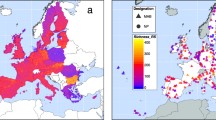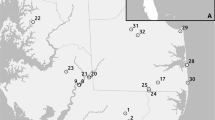The consequences of different measures of biotic diversity for the selection of priority sites for conservation were investigated using a dataset on Afrotropical antelopes. Site networks were selected using species richness, taxonomic diversity and restricted-range diversity as selection criteria. Restricted-range diversity was the most efficient criterion at representing all the species in the dataset. However when only a few sites could be conserved (insufficient to include all species) restricted-range diversity was relatively poor at representing absolute numbers of species and also taxonomic diversity. Use of unweighted species richness rather than a taxonomically weighted score did not significantly reduce the amount of taxonomic diversity represented. As expected an iterative selection of sites was considerably more efficient at representing all aspects of diversity than selection of the top-scoring sites. However the efficiency of an iterative selection procedure was reduced when some areas were already part of the reserve network. Since none of the criteria for selecting reserves maximizes all aspects of biodiversity under all circumstances, it is necessary to be clear about the objectives of a reserve network when deciding on a method for site selection.
Similar content being viewed by others
References
Bedward M., Pressey R.L. and Nicholls A.O. (1991) Scores and score classes for evaluation criteria: a comparison based on the cost of reserving all natural features. Biol. Conserv. 56, 281–94.
Captive Breeding Specialist Group (1992) Conservation Assessment and Management Plans (CAMP). Review summary reports. CBSG 1992 Annual meeting, Vancouver, B. C., Canada. 4–6 September 1992.
East R., (ed.) (1988) Antelopes. Global survey and regional action plans. Part 1. East and North Africa. Gland: IUCN.
East R. (ed.) (1989) Antelopes. Global survey and regional action plans. Part 2. South and South-Central Africa. Gland: IUCN.
East R. (ed.) (1990) Antelopes. Global survey and regional action plans. Part 3. West and Central Africa. Gland: IUCN.
Gentry A.W. (1992) The subfamilies and tribes of the family Bovidae. Mammal Rev. 22, 1–32.
Kirkpatrick J.B. (1983) An iterative method for establishing priorities for the selection of nature reserves: an example from Tasmania. Biol. Conserv. 25, 127–34.
Margules C.R., Nicholls A.O. and Pressey R.L. (1988) Selecting networks of reserves to maximise biological diversity. Biol. Conserv. 43, 63–70.
Noss R.F. (1991) From endangered species to biodiversity. In Balancing on the brink of extinction: the Endangered Species Act and lessons for the future (K. Kohm, ed.) pp. 227–46. Washington: Island Press.
Pressey R.L. and Nicholls A.O. (1989a) Efficiency in conservation evaluation: scoring versus iterative approaches. Biol. Conserv. 50 199–218.
Pressey R.L. and Nicholls A.O. (1989b) Application of a numerical algorithm to the selection of reserves in semi-arid New South Wales. Biol. Conserv. 50, 263–78.
Salwasser H. (1991) In search of an ecosystem approach to endangered species conservation. In Balancing on the brink of extinction: the Endangered Species Act and lessons for the future (K. Kohm, ed.) pp. 247–65. Washington: Island Press.
Scott J.M., Davis F., Csuti B., Noss R.F., Butterfield B., Groves C., Anderson H., Caicco S., D'Erchia F., Edwards T.C., Ulliman J. and Wright R.G. (1993) Gap analysis: a geographic approach to protection of biological diversity. Wildl. Monogr. 123, 1–41.
Smith K.A. (1988) Endangered species management: a single species approach to the loss of biological diversity? Trans. West. Sect. Wildl. Soc. 24, 8–11.
Thirgood, S.J. and Heath, M.F. (In press) Global patterns of endemism and the conservation of biodiversity. In Systematics and Conservation Evaluation (P.L. Forey, C.J. Humphries, and R.I. Vane-Wright, eds) Special volume of the Systematics Association. Oxford: Clarendon Press.
Vane-Wright R.I., Humphries C.J. and Williams P.H. (1991) What to protect?-Systematics and the agony of choice. Biol. Conserv. 55, 235–54.
Williams, P.H. (1992) WORLDMAP priority areas for biodiversity. Using version 3. Privately distributed, London.
Williams P.H. (1993) Choosing conservation areas: using taxonomy to measure more of biodiversity. In International Symposium on Biodiversity and Conservation (T.Y. Moon, ed.). Manus. Col. ISBC. KEI, pp. 194–227. Seoul: Korean Entomological Institute.
Williams P.H., Humphries C.J. and Vane-Wright R.I. (1991) Measuring biodiversity: taxonomic relatedness for conservation priorities. Aust. Syst. Bot. 4, 665–79.
Williams, P.H. and Humphries, C.J. (in press). Biodiversity, Taxonomic Relatedness and Endemism in Conservation. In Systematics and Conservation Evaluation (P.L. Forey, C.J. Humphries, and R.I. Vane-Wright, eds). Special volume of the Systematics Association. Oxford: Clarendon Press.
Author information
Authors and Affiliations
Rights and permissions
About this article
Cite this article
Kershaw, M., Williams, P.H. & Mace, G.M. Conservation of Afrotropical antelopes: consequences and efficiency of using different site selection methods and diversity criteria. Biodivers Conserv 3, 354–372 (1994). https://doi.org/10.1007/BF00056508
Received:
Accepted:
Issue Date:
DOI: https://doi.org/10.1007/BF00056508




